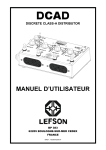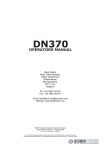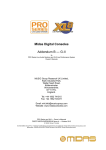Download Midas XL42 Specifications
Transcript
XL42 OPERATORS MANUAL Telex Communications (UK) Ltd. Klark Teknik Building Walter Nash Road Kidderminster Worcestershire DY11 7HJ England Tel: +44 1562 741515 Fax: +44 1562 745371 Website: www.midasconsoles.com XL42 Dual Channel Strip Operators Manual DOC02-XL42 Issue B - December 2005 © Telex Communications (UK) Ltd. In line with the company’s policy of continual improvement, specifications and function may be subject to change without notice. E&OE. IMPORTANT SAFETY INSTRUCTIONS CAUTION RISK OF ELECTRIC SHOCK DO NOT OPEN WARNING: TO REDUCE THE RISK OF FIRE OR ELECTRIC SHOCK, DO NOT EXPOSE THIS APPLIANCE TO RAIN OR MOISTURE AVIS: RISQUE DE CHOC ELECTRIQUE. NE PAS OUVRIR These symbols are internationally accepted symbols that warn of potential hazards with electrical products. The lightning flash with arrowhead symbol, within an equilateral triangle is intended to alert the user to the presence of uninsulated “dangerous voltage” within the product's enclosure that may be of sufficient magnitude to constitute a risk of electric shock to persons. The exclamation point within an equilateral triangle is intended to alert the user to the presence of important operating and maintenance (servicing) instructions in the literature accompanying the appliance. 1. Read these instructions. 2. Keep these instructions. 3. Heed all warnings. 4. Follow all instructions. 5. Do not use this apparatus near water. 6. Clean only with a dry cloth. 7. Do not block any of the ventilation openings. Install in accordance with the manufacturers instructions. 8. Do not install near any heat sources such as radiators, heat registers, stoves, or other apparatus (including amplifiers) that produce heat. 9. Do not defeat the safety purpose of the polarized or grounding-type plug. A polarized plug has two blades with one wider than the other. A grounding type plug has two blades and a third grounding prong. The wide blade or the third prong are provided for your safety. If the provided plug does not fit into your outlet, consult an electrician for replacement of the obsolete outlet. 10. Protect the power cord from being walked on or pinched particularly at plugs, convenience receptacles, and the point where they exit from the apparatus. 11. Only use attachments / accessories specified by the manufacturer. 12. Unplug this apparatus during lightning storms or when unused for long periods of time. 13. Refer all servicing to qualified personnel. Servicing is required when the apparatus is damaged in any way, such as power-supply cord or plug is damaged, liquid has been spilled or objects have fallen into the apparatus, the apparatus has been exposed to rain or moisture, does not operate normally, or has been dropped. Klark Teknik Group (UK) Plc, Klark Teknik Building, Walter Nash Road, Kidderminster. Worcs. DY11 7HJ. England Tel:+44 1562 741515 Fax:+44 1562 745371 www.midasconsoles.com www.klarkteknik.com DECLARATION OF CONFORMITY We, Klark Teknik Group (UK) PLC of, Klark Teknik Building, Walter Nash Road, Kidderminster, Worcestershire, DY11 7HJ Declare that a sample of the following product:Product Type Number XL42 Product Description Dual Channel Strip Nominal Voltage (s) 230V/115V Current 70mA / 140mA Freq 50/60Hz to which this declaration refers, is in conformity with the following directives and/or standards:- Directive(s) Test Standard(s) 89/336/EEC Electromagnetic Compatibility Directive amended by 92/31/EEC & 93/68/EEC 73/23/EEC Low Voltage Directive amended by 93/68/EEC Generic Emissions Standard Generic Immunity Standard Electrical Safety Signed:............................ EN55013:1990 EN50082:1992 UL6500-03(Pending at time of publication) E60065-03(Pending at time of publication) EN60065:2002(Pending at time of publication) Date: 7th May 2004 Name: Simon Harrison Authority: Research & Development Director, Klark Teknik Group (UK) PLC Attention! Where applicable, the attention of the specifier, purchaser, installer or user is drawn to special limitations of use which must be observed when these products are taken into service to maintain compliance with the above directives. Details of these special measures and limitations to use are available on request and are available in product manuals. A Subsidiary of Telex communications, Inc. Contents Contents Thank you for using a Midas XL42 dual channel creative equaliser. The XL42 has been developed to meet the needs of demanding live sound engineers and meets the quality of build and performance that you would expect from a Midas product. The XL42 is backed up by the standard Midas Three Year Warranty. Please take the time to complete and return the registration card. In view of this flexibility, we hope that you will spend a little time reading through this operators' manual, as this will allow you to obtain the best results from your XL42 with a minimum of effort. Finally, enjoy your new Midas XL42! Contents Introduction 1 Before You Start Installation Precautions Voltage Selection and Power Connection Safety Warning Attention! Cables Electric Fields 2 2 2 2 2 2 After You Have Unpacked the Unit 3 Front Panel Input section EQ section Output section 5 6 7 8 Rear Panel 9 System Connection 13 Auto-mute Operation 14 Daisy Chain Operation 15 Technical Specification 17 XL42 Operators Manual - Page i Contents Contents XL42 Operators Manual - Page ii Introduction The Midas XL42 is a 1U rack mounting, dual channel creative equaliser incorporating the XL4 four-band parametric equalisation and XL4 mic/line pre-amplifiers with +48V phantom power. Each channel has input gain, output level and pan rotary controls, 10-segment LED metering plus a switchable insert send and return point. The XL42 also features Automute scene control from the Automute masters of XL consoles, which are enabled by DIP switches on the rear of the unit. The purpose of this unit is threefold: 1. To improve the audio quality of an inferior console by adding a Midas mic pre-amp and EQ. 2. To create custom mixing consoles through the ability to daisy chain multiple units. When linked together, the combined outputs will sum, producing discrete L&R channels. 3. If a production requires, for example, 10 channels more than the input capacity of the master console, five XL42s can be fitted in a standard rack together with any required dynamic processing, which can be inserted via the XL42's insert points; thus creating a custom 10 into 2 mixer via the output daisy chain feature. The resulting L and R outputs may then be routed to the master console via any convenient point, such as, a pair of aux returns, group inputs, matrix inputs etc. As a stand-alone unit, the XL42 is ideally suited to applications requiring a high quality front end, such as stereo recording etc. XL42 Operators Manual - Page 1 Before You Start Installation Precautions Do not install this unit in a location subjected to excessive heat, dust or mechanical vibration. Allow for adequate ventilation around the unit, making sure the unit's vents are not obstructed. To avoid excessive heating of the unit, avoid mounting the unit directly above power amplifiers or other devices that radiate significant amounts of heat. Where necessary, use fan-cooled racks. Voltage Selection and Power Connection Mains power to the XL42 is supplied by means of a standard fused IEC power socket. The XL42 is designed to operate at nominal mains voltages of 115V and 230V AC at either 50 or 60 Hz, however, upon first use (and whenever the mains supply is changed) the input voltage selector on the rear of the unit must be set to reflect the local power supply. This information is also printed on the rear of the unit, below the mains inlet socket. This device must be earthed and must use an approved mains fuse. Before connecting to the mains supply, ensure the fuse fitted is the correct type and rating as indicated on the rear panel (adjacent to fuse holder) and that the correct mains supply voltage is selected. Safety Warning To completely disconnect this equipment from the AC mains, set the power switch to the off position. The power switch shall remain readily operable. Do not expose this equipment to dripping or splashing and ensure that no objects filled with liquids, such as vases, are placed on the equipment. For safety reasons the earth lead for this unit should never be disconnected. In the event of ground loop problems, under no circumstances must the mains earth be removed. Instead, disconnect the signal screen at one end of the connecting cables. Please note that this can only be done when the unit is being used within a balanced system. To prevent shock or fire hazard, do not expose the unit to rain or moisture. To avoid electrical shock do not remove covers. Refer servicing to qualified personnel only. Attention! Cables The inputs and outputs are balanced on conventionally wired XLRs (pin 1 screen, pin 2 hot and pin 3 cold). This product should only be used with high quality, screened twisted pair audio cables, terminated with metal-bodied 3-pin XLR connectors. Any other cable type or configuration for the audio signals may result in degraded performance due to electromagnetic interference. Note: The +48V phantom power can only be used with balanced cables. Electric Fields Should this product be used in an electromagnetic field that is amplitude modulated by an audio frequency signal (20Hz to 20kHz), the signal to noise ratio may be degraded. Degradation of up to 60dB at a frequency corresponding to the modulation signal may be experienced under extreme conditions (3V/m, 90% modulation). No permanent damage or degradation of performance will be caused by these conditions. XL42 Operators Manual - Page 2 After You Have Unpacked the Unit Before unpacking the XL42, check packaging for signs of damage, as this could be an indication of damage to the unit inside. After unpacking the XL42, check the unit for signs of damage to the casing. Damage to consignments must usually be reported to the courier within 24 hours in order for a claim to be made. Please retain the packaging for your XL42, as it will prove useful if you need to transport the unit. Please also retain the XL42's Operators Manual (this document) and any other associated documentation. XL42 Operators Manual - Page 3 After You Have Unpacked the Unit XL42 Operators Manual - Page 4 Front Panel The XL42 is a highly featured 1U 19” rackmount, dual channel strip. The unit is split into two identical channel strips, each with identical functionality but having independent inputs and outputs. Power On/Off switch: Conventional latching type switch, which is on when in its fully in position and off when fully out. The action of the switch is firm but does not require excessive force, which may damage the unit. A red LED, to the left of the power switch, illuminates to indicate that the XL42 is receiving mains power. Output section EQ section Input section XL42 Operators Manual - Page 5 Front Panel Input section mic/line gain control knob: Gives a continuously variable input gain control depending upon the input selected, where: Mic: +15dB to +70dB gain Mic (PAD enabled): -10dB to +45dB Ø switch: Phase switch inverts the input signal by applying a 180° phase shift. +48 switch: Phantom power +48V switch allows connection of devices that require phantom power, such as, condenser microphones, direct inject (DI) boxes etc. PAD switch: The line/pad switch provides 25dB of attenuation to the input signal and allows the connection of high output microphones or line level signals. If using the XL42's optional transformercoupled input, the pad greatly reduces the risk of saturation at very low frequencies. XL42 Operators Manual - Page 6 Front Panel EQ section The bass, lo-mid, hi-mid and treble bands use dual concentric rotary controls. The outside ring controls the band cut and boost in the range -15dB to +15dB. The inner ring of the dial controls the bandwidth of the filter in the range 0.1 to 2 octaves (with a centre detent at 0.5 octave). bass dual concentric rotary control knob: Bass band gain/attenuation adjustment is via inner control knob. Bass bandwidth is adjusted using the outer control ring, enabled via bell switch (immediately below). freq (lo-cut) control knob: Lo-cut filter control selects the HPF frequency and is continuously variable from 20Hz to 400Hz. Enabled by the lo-cut switch. lo-mid dual concentric rotary control knob: Lo-mid band gain/attenuation adjustment is via inner control knob. Lo-mid bandwidth is adjusted using outer control ring. freq (lo-mid) control knob: Lo-mid control selects frequency at which the lo-mid equaliser band acts and is continuously variable from 100Hz to 2KHz. lo-cut switch: Conventional latching switch that enables lo-cut filter when switch is on, that is, in its fully in position. freq (bass) control: Selects frequency at which the bass equaliser band acts; continuously variable from 20Hz to 400Hz. treble dual concentric rotary control knob: Treble band gain/attenuation adjustment is via inner control knob. Treble bandwidth is adjusted using outer control ring, activated by bell switch (immediately below). hi-mid dual concentric rotary control knob: Hi-mid band gain/attenuation adjustment is via inner control knob. Hi-mid bandwidth is adjusted using outer control ring. eq switch: Enables/disables equaliser in the signal path. freq (treble) control: Selects frequency at which the treble equaliser band acts; continuously variable from 1KHz to 20KHz. freq (hi-mid) control: Selects frequency at which the hi-mid equaliser band acts; continuously variable from 400Hz to 8kHz. bell (bass) switch: Conventional latching switch enables/disables parametric EQ for the bass band. When switch is in fully in position, equaliser band will work in full parametric mode. Otherwise, equaliser band acts like a traditional MIDAS shelving response EQ. XL42 Operators Manual - Page 7 bell (treble) switch: Conventional latching switch enables/disables parametric EQ for the treble band. When switch is in fully in position, equaliser band will work in full parametric mode. Otherwise equaliser band acts like a traditional MIDAS shelving response EQ. Front Panel Output section level/pan dual concentric rotary control knob: Adjusts pan or output level. Pan control places the input within a stereo (left/right) mix and has a constant power law such that, at its centre position, each output is attenuated by 3dB. Pan control is enabled by the PAN switch (immediately below) and is adjusted using the outer control ring. With PAN switch off, the XL42 is essentially two independent channel strips. With PAN switch on, the output signal from each input strip is distributed between the two outputs. The output level, adjust by the inner control knob, controls the output level in the range -¥ (infinity) to +10dB. Output peak level meter: Monitors the level of the channel. By default, this is post-output level and pan, although it may be internally set to be pre-level pan and insert. INS switch: Selects whether the insert circuitry is patched into the audio signal path. When the switch enabled (on, fully in position) then the insert jacks are patched into the audio signal path. MUTE switch: Mutes the channel outputs. Mute may also be controlled via the Automute link selected via the "REMOTE CONTROL AUTOMUTE ASSIGNS" DIP switches on the rear panel Note: the insert point can be configured internally using jumpers to be pre- or post- EQ. The factory default setting is Pre-EQ. PAN switch: Enables the pan control on the level/pan dual concentric rotary control knob. XL42 Operators Manual - Page 8 LEFT INPUT LEFT LINK INPUT RIGHT INPUT RIGHT LINK INPUT RETURN SEND RETURN SEND The XL42 rear panel houses both the input and output sockets as well as the insert points, remote control and Automute sockets, and power inlet and selector. Left and right inputs Left and right link inputs Left and right outputs Left and right insertion points LEFT TO REDUCE THE RISK OF FIRE, REPLACE FUSE WITH THE SAME TYPE AND RATING REMPLACER PAR WARNING UN FUSIBLE DE DO NOT EXPOSE MEME TYPE THIS APPLIANCE TO CAUTION ATTENTION RISQUE RAIN OR MOiSTURE THIS DE CHOC NE EQUIPMENT SUPPLY PAS ENLEVER MUST BE VOLTAGE FUSE 5X20mm EARTHED 115V T315mAL250V 115 / 230V~ 50-60Hz 40W 230V T160mAL250V AUTOMUTE LINK RIGHT INSERTION POINTS RIGHT LEFT REMOTE CONTROL AUTOMUTE ASSIGNS AUTOMUTE INPUT NRTL/C 1995 RIGHT OUTPUT PUSH PUSH LEFT OUTPUT PUSH PUSH Rear Panel Left and right remote control Automute assigns Automute input and link 230 Supply voltage selector switch IEC Power Inlet. Your XL42 should come complete with the correct IEC mains lead for the country in which it was intended for sale. If replacing the mains lead, replace with a recommended part and ensure that the fuse is of the correct type. The XL42 must be earthed. XL42 Operators Manual - Page 9 Rear Panel Left and right link inputs: When used in a daisy chain, the link input is summed with the output from the XL42's input channels to the output so that the daisy chain may continue. A much larger console can be created by adding extra XL42s using the output from the last XL42 in the chain as the master output. Input impedances: Maximum input level: 20kOhm Balanced +21dBu The Left and Right link inputs may be configured using internal jumpers to sum with the channel input Preor Post- Output Level, Pan and Mute. The factory default setting is post Output Level, Pan and Mute. Left and right inputs: Balanced XLR input to the channel strip from microphones, DI boxes, line etc. RIGHT OUTPUT PUSH PUSH RIGHT LINK INPUT RIGHT INPUT Input impedances: Mic: Mic (with PAD): 2kOhm Balanced 3kOhm Balanced Maximum input level: Mic: Mic (with PAD): +6dBu +31dBu PUSH PUSH LEFT LINK INPUT LEFT INPUT LEFT OUTPUT Left / Right Output: Balanced XLR output from the channel strip. The output signal will be a combination of the link input plus the output from the XL42's input channels. If pan is selected on either of the inputs, the outputs will be a stereo combination of the input channels plus the link input. If pan is disabled on the channels, the output will be a combination of the input channel and the link input only. Please note that if one input channel has pan enabled and one does not, the channel with pan enabled obeys the pan law of the pan pot. However, no signal is introduced into the other output. Only when both channel pan switches are enabled does the unit enter full stereo mode, that is, either output can be a combination of either input. Maximum output level: +21dBu The Left and Right Outputs may be internally configured using jumpers to be pin 2 or pin 3 hot. Factory default setting is pin 2 hot. XL42 Operators Manual - Page 10 Rear Panel Supply voltage selector switch: The supply voltage is switchable between 115VAC and 230VAC, and should be set to the mains power supply available in the country in which the unit is to be used. Caution! The supply voltage selector switch must be set BEFORE plugging the unit into the mains. UNDER NO CIRCUMSTANCES should the switch be changed whilst the unit is plugged in. Remote Control Automute Assigns: The 9-pin plug for the Automute system allows up to 8 Automute channels. The input channels of the XL42 can be set to mute on one of these 8 Automute channels by switching on the corresponding channel number on the DIP switch for the XL42's input channels. AUTOMUTE INPUT 230 WARNING DO NOT EXPOSE THIS APPLIANCE TO RAIN OR MOiSTURE NRTL/C 1995 REMOTE CONTROL AUTOMUTE ASSIGNS SUPPLY VOLTAGE 115 / 230V~ 50-60Hz 40W RIGHT AUTOMUTE LINK LEFT INSERTION POINTS RIGHT LEFT RETURN SEND RETURN SEND Automute link/Automute input: Automute link socket can be used to extend the Automute connection to other XL42s in the daisy chain. Automute input should be wired according to diagram below. 12345 6789 54321 9876 Pin Pin Pin Pin Pin Pin Pin Pin Pin 1 2 3 4 5 6 7 8 9 Automute Automute Automute Automute Automute Automute Automute Automute Common 1 2 3 4 5 6 7 8 Left and right insertion points: Insert points can be used to add additional processing into the signal path, for example, Dynamics Processors, Graphic EQ, Effects, etc. Input impedance: Maximum input level: 20kOhm Balanced +21dBu The insert send and return are on independent balanced Bantam Jacks. The insert point can be configured internally using jumpers to be pre- or post- EQ. The factory default setting is Pre-EQ. XL42 Operators Manual - Page 11 Rear Panel XL42 Operators Manual - Page 12 System Connection The XL42 is a versatile expansion to any system, or a complete system on its own. You can use it: As a replacement for an inferior mic pre-amp. ! Plug the microphone or DI box into the XL42 and the output into the line input of your console. You can also use the XL42 EQ and bypass your console's EQ. Set PAN to off for mono operation or on for stereo operation. As a better EQ section for your console. ! Plug the XL42 into the insert point of your console (Desk Send to XL42 Input and XL42 Output to Desk Return). Set the PAD switch on the XL42 to the in position in for a line level signal. As an expansion to your console. ! Connect your XL42s in a daisy chain configuration. Connect outputs from the last XL42 into a stereo channel (or two mono channels) on your console or into a stereo/effects return. As a high quality pre-amp and EQ. ! Plug your microphones, such as a stereo condenser pair for recording, into the XL42 and the outputs into a DAT, CD or hard disk recorder. The XL42 is the perfect companion for any system and could even be used for computer audio or drum sub-mixing where a high quality pre-amp and EQ is required. XL42 Operators Manual - Page 13 Auto-Mute Operation The XL42 can be used within an Automute system. The standard 9-pin plug can control up to eight independent mono channels, each of which can be addressed by the XL42. To assign an Automute address for each channel, the REMOTE CONTROL AUTOMUTE ASSIGNS should be turned on for the desired Automute address, that is, LEFT ASSIGN 2 would make the left-hand channel of the XL42 mute on channel 2 of the Automute system. AUTOMUTE INPUT NRTL/C REMOTE CONTROL AUTOMUTE ASSIGNS AUTOMUTE LINK RIGHT LEFT Each channel may be assigned to more than one Automute channel by switching each of the required DIP switches. The Automute plugs are wired as follows: 12345 6789 54321 Pin Pin Pin Pin Pin Pin Pin Pin Pin 1 2 3 4 5 6 7 8 9 Automute Automute Automute Automute Automute Automute Automute Automute Common 1 2 3 4 5 6 7 8 9876 The XL42 Automute system is compatible with all MIDAS XL series consoles, hence the XL42 is an ideal expansion to an XL series console when extra channels are required. XL42 Operators Manual - Page 14 Daisy-Chain Operation A number of XL42s can be connected in a daisy chain configuration to form a larger console or to expand an existing console. (32 channels of XL quality EQ and mic pre-'s will fit into a 16U.) Inputs 1 and 2 Automute input 230 TO REDUCE THE RISK OF FIRE, REPLACE FUSE WITH THE SAME TYPE AND RATING AUTOMUTE INPUT REMPLACER PAR WARNING UN FUSIBLE DE DO NOT EXPOSE MEME TYPE THIS APPLIANCE TO CAUTION ATTENTION RISQUE RAIN OR MOiSTURE THIS DE CHOC NE SUPPLY EQUIPMENT PAS ENLEVER MUST BE VOLTAGE FUSE 5X20mm EARTHED 115 / 230V~ 50-60Hz 40W 115V T315mAL250V AUTOMUTE LINK 230V T160mAL250V 230 TO REDUCE THE RISK OF FIRE, REPLACE FUSE WITH THE SAME TYPE AND RATING AUTOMUTE INPUT REMPLACER PAR WARNING UN FUSIBLE DE DO NOT EXPOSE MEME TYPE THIS APPLIANCE TO CAUTION ATTENTION RISQUE RAIN OR MOiSTURE THIS DE CHOC NE SUPPLY EQUIPMENT PAS ENLEVER MUST BE VOLTAGE FUSE 5X20mm EARTHED 115 / 230V~ 50-60Hz 40W 115V T315mAL250V AUTOMUTE LINK 230V T160mAL250V 230 TO REDUCE THE RISK OF FIRE, REPLACE FUSE WITH THE SAME TYPE AND RATING AUTOMUTE INPUT REMPLACER PAR WARNING UN FUSIBLE DE DO NOT EXPOSE MEME TYPE THIS APPLIANCE TO CAUTION ATTENTION RISQUE RAIN OR MOiSTURE THIS DE CHOC NE SUPPLY EQUIPMENT PAS ENLEVER MUST BE VOLTAGE FUSE 5X20mm EARTHED 115 / 230V~ 50-60Hz 40W 115V T315mAL250V AUTOMUTE LINK 230V T160mAL250V 230 TO REDUCE THE RISK OF FIRE, REPLACE FUSE WITH THE SAME TYPE AND RATING AUTOMUTE INPUT REMPLACER PAR WARNING UN FUSIBLE DE DO NOT EXPOSE MEME TYPE THIS APPLIANCE TO CAUTION RAIN OR MOiSTURE ATTENTION RISQUE THIS DE CHOC NE SUPPLY EQUIPMENT PAS ENLEVER MUST BE VOLTAGE FUSE 5X20mm EARTHED 115 / 230V~ 50-60Hz 40W 115V T315mAL250V AUTOMUTE LINK 230V T160mAL250V NRTL/C REMOTE CONTROL AUTOMUTE ASSIGNS RIGHT LEFT NRTL/C REMOTE CONTROL AUTOMUTE ASSIGNS RIGHT LEFT NRTL/C REMOTE CONTROL AUTOMUTE ASSIGNS RIGHT LEFT NRTL/C REMOTE CONTROL AUTOMUTE ASSIGNS RIGHT LEFT PUSH PUSH RIGHT LINK INPUT RIGHT INPUT PUSH PUSH RIGHT LINK INPUT RIGHT INPUT PUSH PUSH RIGHT LINK INPUT RIGHT INPUT PUSH PUSH RIGHT LINK INPUT RIGHT INPUT PUSH PUSH LEFT LINK INPUT LEFT INPUT PUSH PUSH LEFT LINK INPUT LEFT INPUT PUSH PUSH LEFT LINK INPUT LEFT INPUT PUSH PUSH LEFT LINK INPUT LEFT INPUT Inputs 3 and 4 1995 INSERTION POINTS RIGHT LEFT RETURN SEND RETURN SEND RIGHT OUTPUT LEFT OUTPUT Inputs 5 and 6 1995 INSERTION POINTS RIGHT LEFT RETURN SEND RETURN SEND RIGHT OUTPUT LEFT OUTPUT Inputs 7 and 8 1995 INSERTION POINTS RIGHT LEFT RETURN SEND RETURN SEND RIGHT OUTPUT LEFT OUTPUT 1995 INSERTION POINTS RIGHT LEFT RETURN SEND RETURN SEND RIGHT OUTPUT LEFT OUTPUT “Master” outputs - to mixer, amplifer or recording device As shown in the diagram above, each channel has its own input plus the output from the previous XL42 so that at the last point of the chain, the output is a combination of each input. Depending on the use of each channel PAN, this may be a stereo image or all the left-hand channels grouped and all the right-hand channels grouped. Optionally, you may wish to use the Automute feature. Here the output from the master console (any MIDAS XL series) is inserted at the top of the chain and linked into each unit. XL42 Operators Manual - Page 15 Daisy-Chain Operation XL42 Operators Manual - Page 16 Technical Specification 0 60 160 6 400 -15 0 6 0 6 6 0 6 6 1 0.1 2 +/- +15 +70 mic/line gain PAD +48 /O line/pad phase 20 freq 60 +15 -15 160 bass300 +15 -15 lo-cut 20 freq 400 bell 100 freq 2k eq 400 +15 -15 3k hi-mid 3k 1k lo-mid 1k freq 8k 1k 8k freq treble 20k +15 bell TO REDUCE THE RISK OF FIRE, REPLACE FUSE WITH THE SAME TYPE AND RATING AUTOMUTE INPUT REMPLACER PAR WARNING UN FUSIBLE DE DO NOT EXPOSE MEME TYPE THIS APPLIANCE TO CAUTION RAIN OR MOiSTURE ATTENTION RISQUE THIS DE CHOC NE SUPPLY EQUIPMENT PAS ENLEVER MUST BE VOLTAGE FUSE 5X20mm EARTHED 115 / 230V~ 50-60Hz 40W 115V T315mAL250V AUTOMUTE LINK 230V T160mAL250V 230 0.3 +15 +12 +9 +6 +3 0 +10 -3 level/pan -6 -9 INS PAN MUTE -12 0 6 6 level pan +25 +15 +35 +70 RIGHT LEFT 20 mic/line gain PAD +48 /O line/pad phase NRTL/C REMOTE CONTROL AUTOMUTE ASSIGNS 0 60 freq 160 6 400 -15 60 0 6 +15 -15 160 bass300 0 6 6 +15 -15 2k eq 400 freq 8k +15 -15 1k 6 6 3k hi-mid 3k 1k lo-mid 1k lo-cut 20 freq 400 bell 100 freq 0 6 6 8k freq treble 20k PUSH PUSH RIGHT LINK INPUT RIGHT INPUT bell +15 +15 +12 +9 +6 +3 0 +10 -3 level/pan -6 -9 INS PAN MUTE -12 0 0 0 +35 0 0 +25 width level XL42 ON pan PUSH PUSH LEFT LINK INPUT LEFT INPUT 1995 INSERTION POINTS RIGHT LEFT RETURN SEND RETURN SEND RIGHT OUTPUT LEFT OUTPUT Input Impedance Mic Mic + Pad Link & Insert 2kOhm Balanced 3kOhm Balanced 20kOhm Balanced Input Gain (all controls at 0dB) Mic Mic + Pad Link & Insert Continuously variable from +15dB to +70dB Continuously variable from -10dB to +45dB 0dB Maximum Input Level Mic Mic + Pad Link & Insert +6dBu +31dBu +21dBu CMR at 1kHz Mic (gain + 60dB) Mic + Pad (gain +35dB) Link & Insert >70dB >50dB >60dB Frequency Response (20Hz to 20kHz) Any input +0dB to -1dB Noise (20Hz to 20kHz) Mic EIN ref. 150 Ohm (gain + 60dB) Transformer Mic Input EIN ref. 150 Ohm (gain + 60dB) System Noise at 0dB (one channel only) -129dBu -127dBu -88dBu System Noise (20 to 20kHz) Summing Noise (12 channels routed with faders down) Line to Mix Noise (12 channels routed at 0dB, pan centre) Summing Noise (48 channels routed with faders down) Line to Mix Noise (48 channels routed at 0dB, pan centre) -83dB -81dB -81dB -75dB Distortion at 1kHz Mic (+ 40dB gain, 0dBu output) Link (0dBu) <0.03% <0.03% Output Impedance All Outputs 50 Ohm Balanced Source to drive >600 Ohm Maximum Output Level All Outputs 50 Ohm Balanced Source to drive >600 Ohm into >600 Ohm +21dBu XL42 Operators Manual - Page 17 Technical Specification Metering Type 10 Segment LED Bargraph - Peak Reading Equaliser Hi pass slope Hi pass frequency 12dB/Oct Continuously variable -3dB point from 10Hz to 400Hz Treble Gain Treble Shelving Freq. Treble Bell Freq. Treble Bell Bandwidth Hi Mid Gain Hi Mid Freq. Hi Mid Bandwidth Lo Mid Gain Lo Mid Freq. Lo Mid Bandwidth Bass Gain Bass Shelving Freq. Bass Bell Freq. Bass Bell Bandwidth Continuously variable +15dB to -15dB Centre detent = 0dB Continuously variable - 3dB point from 1kHz to 20kHz Continuously variable centre from 1kHz to 20kHz Continuously variable 0.1 Oct. to 2 Oct Centre detent = 0.5 Oct Continuously variable +15dB to -15dB Centre detent = 0dB Continuously variable centre from 400Hz to 8kHz Continuously variable 0.1 Oct. to 2 Oct. Centre detent = 0.5 Oct Continuously variable +15dB to -15dB Centre detent = 0dB Continuously variable centre from 100Hz to 2kHz Continuously variable 0.1 Oct. to 2 Oct Centre detent = 0.5 Oct Continuously variable +15dB to -15dB Centre detent = 0dB Continuously variable - 3dB point from 20Hz to 400Hz Continuously variable centre from 20Hz to 400Hz Continuously variable 0.1 Oct. to 2 Oct Centre detent = 0.5 Oct Automute System Channel Quantity Mute ON Voltage Mute Off Voltage Mute Line Load 8 +3 to +20V -20 to +2V >500kOhm Power Nominal Mains Voltage Mains Consumption Phantom Voltage Supply Maximum Phantom Current 115V/230V 40W +48V ± 5% <10mA Dimensions Width Depth Height 482mm (19 inches) 250mm (10 inches) 44mm (1.75 inches) Weight Nett Shipping 3kg 4kg Options Mic Transformer Factory-Fit Only Output Transformer Factory-Fit or Retro-fit XL42 Operators Manual - Page 18 Notes XL42 Operators Manual - Page 19





































